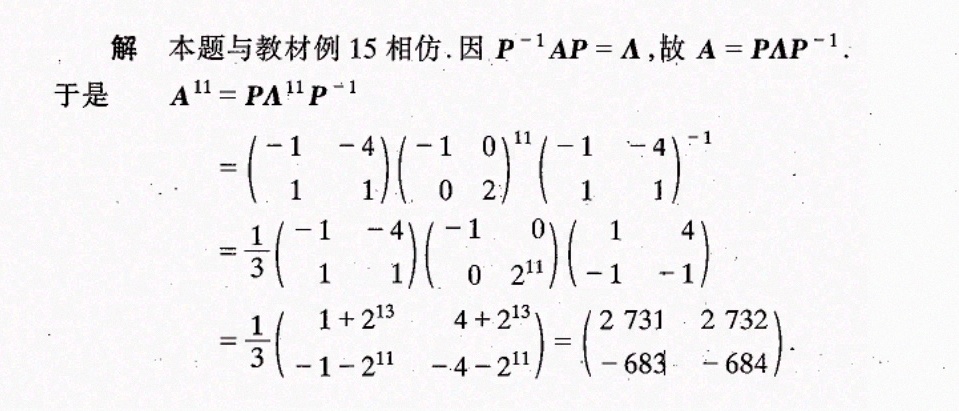(21.设 ^-1AP=A ,其中P= (} -1& -4 1& 1 ) . ,求A^11.

题目解答
答案

解析
考查要点:本题主要考查矩阵的相似对角化及其在计算高次幂中的应用。关键在于利用矩阵的对角化形式简化幂运算。
解题思路:
- 识别条件:题目给出矩阵$P$和$A$满足$P^{-1}AP = A$,暗示$A$可对角化,即存在可逆矩阵$P$使得$A = PDP^{-1}$,其中$D$为对角矩阵。
- 对角化分解:通过$P$和$D$的分解,计算$A^{11}$时可转化为$PD^{11}P^{-1}$,避免直接计算高次幂的复杂性。
- 矩阵运算:需正确计算逆矩阵、矩阵乘法及幂运算。
步骤1:验证矩阵$A$的对角化形式
由题意,$A$可表示为$A = PDP^{-1}$,其中$D$为对角矩阵。观察$A$的结构:
$A = \begin{pmatrix} -1 & 0 \\ 0 & 2 \end{pmatrix}$
可见$A$本身已是分块对角矩阵,其特征值为$-1$和$2$,对应特征向量构成矩阵$P$的列。
步骤2:计算$P^{-1}$
矩阵$P$为:
$P = \begin{pmatrix} -1 & -4 \\ 1 & 1 \end{pmatrix}$
计算行列式$\det(P) = (-1)(1) - (-4)(1) = 3$,故:
$P^{-1} = \frac{1}{3} \begin{pmatrix} 1 & 4 \\ -1 & -1 \end{pmatrix}$
步骤3:计算$D^{11}$
对角矩阵$D$为:
$D = \begin{pmatrix} -1 & 0 \\ 0 & 2 \end{pmatrix}$
其11次幂为:
$D^{11} = \begin{pmatrix} (-1)^{11} & 0 \\ 0 & 2^{11} \end{pmatrix} = \begin{pmatrix} -1 & 0 \\ 0 & 2048 \end{pmatrix}$
步骤4:计算$A^{11} = PD^{11}P^{-1}$
-
计算$P \cdot D^{11}$:
$P \cdot D^{11} = \begin{pmatrix} -1 \cdot (-1) & -4 \cdot 2048 \\ 1 \cdot (-1) & 1 \cdot 2048 \end{pmatrix} = \begin{pmatrix} 1 & -8192 \\ -1 & 2048 \end{pmatrix}$ -
计算$(P \cdot D^{11}) \cdot P^{-1}$:
$\begin{aligned}& \begin{pmatrix} 1 & -8192 \\ -1 & 2048 \end{pmatrix} \cdot \frac{1}{3} \begin{pmatrix} 1 & 4 \\ -1 & -1 \end{pmatrix} \\ &= \frac{1}{3} \begin{pmatrix} 1 \cdot 1 + (-8192) \cdot (-1) & 1 \cdot 4 + (-8192) \cdot (-1) \\ -1 \cdot 1 + 2048 \cdot (-1) & -1 \cdot 4 + 2048 \cdot (-1) \end{pmatrix} \\ &= \frac{1}{3} \begin{pmatrix} 8193 & 8196 \\ -2049 & -2052 \end{pmatrix} \\ &= \begin{pmatrix} 2731 & 2732 \\ -683 & -684 \end{pmatrix} \end{aligned}$